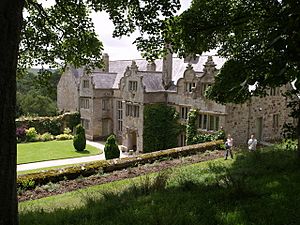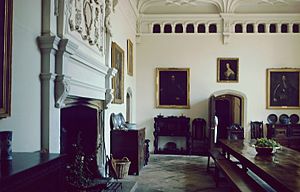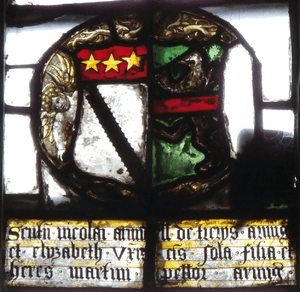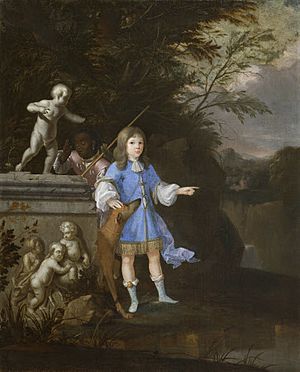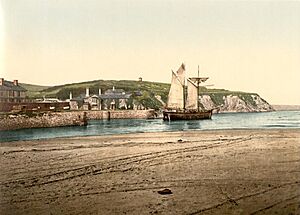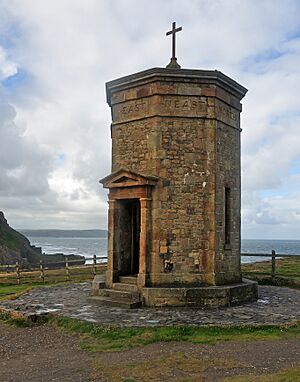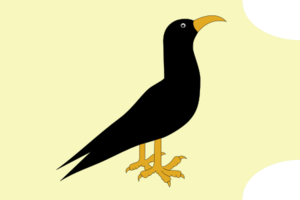Trerice facts for kids
Quick facts for kids Trerice |
|
|---|---|
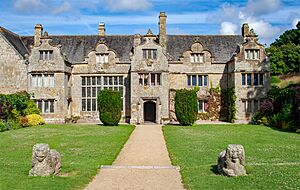
Trerice House, as rebuilt in 1572 by John Arundell
|
|
| Type | Manor House |
| OS grid reference | SW 84115 58478 |
| Built | 15th Century |
| Rebuilt | 1570-73 |
| Owner | National Trust |
|
Listed Building – Grade I
|
|
| Official name: Trerice | |
| Designated | 28 February 1952 |
| Reference no. | 1328731 |
| Lua error in Module:Location_map at line 420: attempt to index field 'wikibase' (a nil value). | |
Trerice (pronounced Tre-rice) is a historic manor located near Newquay, Cornwall, in the United Kingdom. The main house, known as Trerice House, is a Tudor-style building found at Kestle Mill, about three miles east of Newquay. Since 1953, the National Trust has owned the house and its gardens, and it is open for visitors to explore. Trerice House is a Grade I listed building, which means it is a very important historical site. You can also see two stone lions on the front lawn, which are also protected as Grade II listed items. The garden has an orchard with many old types of fruit trees.
Contents
- What's in a Name? The Meaning of Trerice
- Exploring Trerice Manor House
- A Look at Trerice's Past
What's in a Name? The Meaning of Trerice
The name Trerice has a special meaning. The first part, Tre-, is a common word in Cornish and Welsh place names. It means "hamlet," "farmstead," or "estate." This part of the name has been used since the 600s. You can find about 1,300 places with "Tre-" in Cornwall. The second part of the name, -Rice, comes from the name of a person. It means the estate was once held by a man named Rice. So, Trerice means "Rice's farm" or "Rice's estate."
Exploring Trerice Manor House
Trerice House is built in a special shape that looks like the letter 'E' when seen from above. This main part faces the south-east. There's also a south-west part that was built earlier. The very first part of the house was a tower. Later, in the early 1500s, more sections were added. Sir John Arundell added the main 'E'-shaped part of the house around 1570–1573. This is the beautiful building you see today.
A Look at Trerice's Past
From the 1300s until 1768, Trerice was the home of the Arundell family. This family was very important in Cornwall. They used the same family crest as another famous Arundell family from Lanherne. After the Arundell family line ended in 1768, Trerice passed to the Wentworth family. Then, in 1802, it went to the Acland family. The Aclands owned it until 1915, when they sold it to Cornwall County Council.
The Arundell Family at Trerice
The Arundell family was a powerful family in Cornwall. They lived at Trerice for many centuries.
Early Owners: The de Terise Family
The first known owners of Trerice were the de Terise family. They took their name from the manor itself. One important member was Otes de Terise, whose wife Rose Goviley was connected to the Lansladron family. Later, Jane de Flamoke, the last of the de Terise line, married Ralph Arundell. This brought Trerice into the Arundell family.
The Arundells Take Over
The Arundell family became the new owners of Trerice. They were a very important family. Their family crest showed six swallows, which comes from the French word for swallow, hirondelle.
- Ralph Arundell: He married Jane de Terise, the heiress of Trerice, in the 1300s.
- Nicholas Arundell: He married Elizabeth Pellor, whose family arms are seen in old stained glass.
- Sir John Arundell: He was the Sheriff of Cornwall. His second son, Richard, also became Sheriff.
- Nicholas II Arundell: He married Johanna St John, and through her, the Arundells gained more estates in Somerset, like Selworthy and Luccombe.
Stained Glass at Selworthy Church
In Selworthy Church, there is a piece of 15th-century stained glass. It shows the family crest of the St John family, who were ancestors of the Arundells. This glass helps us remember the history of these families.
- Sir John Arundell (c.1428–71): He was also the Sheriff of Cornwall. He sadly died in a battle near St Michael's Mount. He was buried in the chapel there.
- Sir John Arundell (1470–1512): Known as "Jack of Tilbury," he was a Vice-Admiral of the West for King Henry VII and King Henry VIII. He was knighted in 1513. His wife, Jane Grenville, was from another important Cornish family.
- Sir John Arundell (1495–1561): Also known as "Jack of Tilbury," he was a brave soldier and served King Henry VIII. He was knighted after a battle in 1513 and captured a famous pirate. His monumental brass (a special metal plaque) can still be seen in Stratton Church.
Sir John Arundell (died 1580)
John Arundell was the son of the previous Sir John. He was a Member of Parliament and High Sheriff of Cornwall. He is important because he built the beautiful Trerice House we see today, around 1572. The date "1572" is still visible above the fireplace in the Great Hall. He had several children, including Juliana, who married Richard Carew, a famous historian of Cornwall.
Sir John Arundell (1576–1654)
Sir John Arundell, known as "Jack-for-the-King," was a very important figure during the English Civil War. He was a Royalist and served as the Governor of Pendennis Castle. He bravely held the castle during a long five-month siege in 1646. He eventually surrendered honorably. He owned Trerice House and over 2,000 acres of land.
John Arundell, 2nd Baron Arundell (1649–1698)
John Arundell, 2nd Baron Arundell of Trerice inherited the title from his father. He was also a Member of Parliament. He married Margaret Acland, whose family would later inherit Trerice. Her portrait from around 1675 is displayed at Trerice House today.
John Arundell, 3rd Baron Arundell of Trerice (1678–1706)
John Arundell, 3rd Baron Arundell of Trerice was the eldest son and heir. A portrait from the 1680s, possibly of him as a boy, is at Trerice House.
John Arundell, 4th Baron Arundell of Trerice (1701–1768)
John Arundell, 4th Baron Arundell of Trerice was the last of the Arundell family to hold the title. He had no children, so when he passed away in 1768, the Barony of Arundell ended.
The Wentworth Family Takes Over
After the Arundell family line ended, Trerice and its other estates passed to the Wentworth family. William Wentworth became the owner. He later passed the estates to his own son, Frederick Wentworth, 3rd Earl of Strafford.
The Acland Family's Time at Trerice
In 1802, Trerice and other properties went to Sir Thomas Dyke Acland, 10th Baronet. He was a very active owner. He invested a lot in the nearby town of Bude. He helped build a church, a breakwater in the harbor, and even part of the Bude Canal. In 1823, he built a holiday home called "Efford Cottage." He also built the unique octagonal "Storm Tower" in 1835, which was inspired by an ancient Greek tower. It was likely a shelter for coastguards.
The Aclands found it hard to manage the Cornish estates because they were so far from their main home. Around 1844, the 10th Baronet restored the Great Hall at Trerice. He even held a special court there, where about 150 of his tenants came to dine with him. Later, the Aclands leased Trerice to the Tremaine family, who farmed the estate. In 1915, the Aclands sold Trerice to Cornwall County Council.
Cornwall County Council Ownership
After the First World War, the Cornwall County Council became the new owner. They divided the large estate into twelve smaller farms. These farms were either rented out or sold. This left Trerice House with only 20 acres of land around it.
In the summer of 1940, during World War II, the local Home Guard unit from Newquay, nicknamed "The Choughs," used the grounds of Trerice for their drills and exercises.
The National Trust Takes Over
In 1953, the National Trust bought Trerice House and its 20 acres of land for £14,000. At that time, the house was in poor condition.
John Elton's Restoration Work
John Elton, who had been renting Trerice since 1944, got a new 200-year lease from the National Trust in 1953. He paid only one shilling a year, but he promised to use his own money to restore the house. Mr. Elton spent about £60,000, which was much more than he expected, to bring Trerice House back to life. He even rebuilt a part of the house that had been taken down. John Elton left Trerice in 1965 after his wife passed away. He moved to Surrey and continued to live with amazing antiques.


